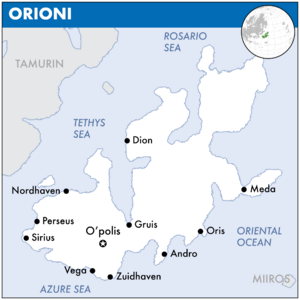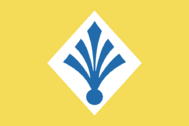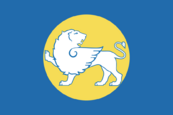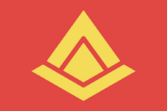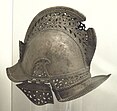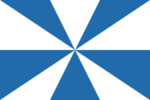List of cities in Orioni
Most cities in Orioni from the First Empire carry the classical suffix -polis (/ˈpɒlɨs/; plural poleis (/ˈpɒleɪz/, [póleːs]), which literally means “city”. Historically, most of these poleis organised themselves as monarchy and mainly focussed on trade. Certain cities specialised in one particular type of commodity. Some colonies experimented with other forms of government, such as the oligarch republic of Primahoris.
About 53% of Orioni is either forested or mountainous, making it largely unsuitable for agricultural, industrial, or residential use. This means that coastal areas contain the habitable zones and have high population densities. The population tends to cluster around fresh-water sources and seaports. As a result, these coastal regions of Orioni are some of the most densely populated areas on Eurth.
Opolis
O'polis (Oharic: Obil) is the capital city of Orioni. The official name is the O'polis NCR (National Capital Region). Both internationally and in daily conversations, the city is referred to as O’polis. With a population of approximately 5,037,655, it is the capital of O'polis province. It is the second-largest city in Orioni. It contains important government facilities, offices and headquarters, and contain the primary residence of the nation's leadership. It's considered the ‘brain’ of the country. The city welcomes visitors, but is complex in both history and layout. There’s a reason that people come back time and time again: this is not a place you can fully comprehend with just one trip. The Orinese capital is both socially tolerant and deeply conservative; its businesses are often friendly but difficult to find. It’s a city where both an old monarchy and a young creative class find common ground. Most tourists enter the city via O’polis International Airport. Sites to visit include: the Bētuni Imperial Palace, Adhamed Arch and Sun Tower.
Its history dates to the 8th century. It was the site of a royal mint during the queendom of Erwanin. After the Orinese Civil War and subsequent sacking of Hierapolis (1174), it became the political capital of Orioni on 11 May 1182. Later, Empress Moriino (1180-1182) further divided the expanded city into 5 regions and ornamented it with public works worthy of an imperial metropolis. The court was supplied from the rich gardens and sophisticated workshops of oriental Europa, with treasuries filled by the wealthiest provinces of the Empire. The name is believed to be composed of Proto-Europan roots 'Urim' (city) and 'Bilum' (high) or 'Belu' (master). This is presumed to be a reference to its location on higher, mountainous upper regions, in contrast to cities on the lower river deltas. The city was called Upala (“gem”) in the Oriental dialect of nearby Shakyan, and Upija by the Memopotamians in Azania. Classical Aromans mistakenly believe it to be an abbreviation for Omnipolis (“city of all”).
O'polis is twinned with the following cities:
Major cities
Andro
Andro (Oharic: Entiro), from Andron (Aroman: ἀνδρών andrōn) or andronitis (Aroman: ἀνδρωνῖτις andrōnitis), established itself as a city-state ruled by a line of male monarchs. This in contrast to most other city-states in the Empire which were matriarchies. Ancient Andro was built into a steep hillside. It was an important maritime centre. The breakwater of its harbour can still be seen underwater.
In 1775, the Andro Academy of Fine Arts (AAFA) in Andro was there as a cost-free training centre for the printing of silk and cotton textiles; this later included the plastic arts. Scholarships permitted many students to travel to O'polis and other Europan centres of studies, where they could dedicate themselves to copying grandmasters' works, a common method of study at the time. The academy's focus evolved toward the fine arts. The academy organised its first exhibition of prize-winning student work in 1786; in the next year's exhibition, other non-student artworks were also displayed. Other courses offered include painting, music, sculpture, architecture, and other fine arts. Over time, the school expanded its curriculum to include more modern forms of art. Since 1953, the AAFA organises the Andro Film Festival.
Corona Borealis
This article or section is in the process of an expansion or major restructuring. You are welcome to assist in its construction by editing it as well. If this article or section has not been edited in several days, please remove this template. If you are the editor who added this template and you are actively editing, please be sure to replace this template with {{in use}} during the active editing session. Click on the link for template parameters to use.
This article was last edited by Orioni (talk | contribs) 2 months ago. (Update timer) |
Corona Borealis (Oharic: Kuruntiya).[a] City in the far north of Orioni. The name evolved from Boreapolis (“city of the north”) into Borealis. The old city sits atop a rocky hill, surrounded by a dense forest of trees on the southern side, and the Rosario Sea to the north. It is a place of rugged beauty, where the cool wind of the north breezes through the streets. But this city is more than just an isolated outpost. It used to be a place of great importance.
This was here that the imperial family fled when civil war broke out in the empire. When the Orinese Civil War erupted in 1023, the imperial family was forced to flee Hierapolis in 1063. The loyalist moved to the northern region of the home island, where the people were still somewhat loyal to their rulers. Because the political capital temporarily moved to Boreapolis, it prompted the name change from Boreapolis to Corona Borealis (“northern crown”).
Despite its relatively remote location, Corona Borealis is a thriving city. During its time as the political capital of the loyalists, Corona Borealis became a hub of activity. It was a place where merchants and traders came to sell their wares at the “Kvánkaj”, where diplomats and politicians conducted their negotiations, and where soldiers trained for battle. Today, the city is a reminder and a symbol of strength and endurance in the face of adversity.
Etymology & history
- Originally a nearby settlement, Kuruntiya, named for a Goddess of the same name. Located on a defensible hill by the sea.
- Later, settled by Buran people, and called Buranpolis, “city of the Buran”. Down by the water.
- Upper and lower city merged into Kurutiya-Buranpolis.
- Internationally known as Corona Borealis,
Cygnus
Cygnus is a colony-city located in the north Semeni region of Orioni, founded by merchants from Vega. It is renowned for its high-quality metallurgy, owing to the nearby rich ore veins in the Mendakh Mountains. The city's Oharic name is Hangsa or Hamsa, and its origins date back to antiquity. The name first appears in the 11th century BCE, when a vassal lord from the Hangsa area sent a type of softshell turtle known as the “Hangsa softshell turtle” to the Dion king as a tribute. In the 2nd century CE, historian Ying Šao wrote that the Nintoku dynasty's used of the name Hangsa for the area was a continuance of its old name.[1]
Cygnus has a population of approximately 800,000 people, and the majority of the city's residents are Oharic speakers. The city has a diverse cultural scene, with a range of museums, galleries, and theatres. The local cuisine is also a highlight, with various dishes featuring local seafood and produce. The city is also home to a thriving tourism industry, with visitors attracted to its rich history and natural beauty. The city's architecture is a blend of traditional and modern styles, reflecting its history as a colony of Vega. Cygnus is well-connected to other parts of Orioni, with a major highway running through the city and a modern airport serving both domestic and international destinations. The city also has a reliable public transportation system, including buses and a metro system.
Cygnus's economy is mainly based on the mining and processing of iron ore, which is exported to other parts of Orioni and beyond. Today, the port of Cygnus is one of the largest iron ore loading ports in Europa, and the largest in Orioni. Between 2016 and 2017, it recorded a throughput of over 550 million tons. In March 2017, Port Cygnus had its record single shipment of 297,000 tons, which was aboard the HL Bedok, a 340-meter-long vessel from Miiros.[2]
Dion
Dion (Oharic: Dion). City of king Dion, who believed he had magical powers that granted his forests exceptional quality. It is a place of great beauty and prosperity. Nestled among the rolling hills and verdant forests of the kingdom, it is a hub of commerce and industry. The name evolved from Dionpolis (“city of Dion”) into Dion.
Dion was a major exporter of timber for shipbuilding. At the heart of Dion lies the great harbour, where ships from all over the country come to load and unload their cargo. The city is renowned for its excellent timber, which is prized for shipbuilding and other construction projects. This wealth of resources has made Dion an important economic player, and its people are known for their hard work and entrepreneurial spirit.
It is also home to the Dion Naval Base, a military facility that helps to protect the kingdom's interests at sea. Here, sailors and soldiers train for battle and conduct exercises to ensure that they are always ready for action.
Gruis
Gruis (Oharic: Tigray) is a coastal city known for its massive harbour cranes. It was the most important transfer port between the central and northern regions. Gruis is leading the way to find creative solutions that balance the need for growth and the preservation of urban spaces. Under then-mayor Awidefale Rezovi the public transportation network saw a necessary expansion. An order for 300 new buses was placed last year, and extensions are ongoing for its light rail and one of its subway lines. This expansion wasn't always well received when a new bill called Proposition 404 threatened to halt further expansion plans and put money towards building more roads instead. Another trend is the ban on e-scooter companies.[3] The name evolved from Tigray over Tigrui into Gruis. The Tigrayans primarily inhabit the highlands between Alnitak and Alnilam. The first mention of Tigray dates from around 900 BCE, when they entered into conflict with the Erwanin queendom.
Meda
Meda (Oharic: Mideya) is one of the oldest cities in Orioni. Meda is a changed city. The recent metamorphosis has been fuelled by the economic crisis and led by a new generation of determined Medanese who have transformed the old city for the better. Both tradition and modernity can be found at the same time. You can marvel at centuries-old masterpieces one moment and enjoy new dishes made by brave chefs the next.
The city of Meda grew rich because of their alchemical knowledge. Remains of highly prized perfumes from Meda have been discovered as far away as Aroma, thanks to the classical Pearl Road trade. The essential components of these perfumes remain unknown, despite their international reputation. Even the MedPharm Group, the multinational pharmaceutical conglomerate that's headquartered in Meda, cannot reconstruct the original chemical combination.[4]
Meda's significance as a trade and cultural hub is highlighted by its pivotal role in the Trans-Thalassan trade network, distinguishing it from the Eurocentric focus prevalent in the western region of Weriki. This distinction is evident both historically and in contemporary times, underlining the city's long-standing tradition of external relations. A notable example of this eastward orientation was the establishment of a dedicated Thalassan language institute at Meda University, emphasising the city's commitment to fostering linguistic and cultural exchanges across the Oriental Ocean. Furthermore, historical records suggest that Meda may have enjoyed a special relationship with Matroilan, which is known today as the Sunset Sea Islands. This relationship underscores Meda's strategic importance in facilitating cross-cultural dialogue and trade relations, cementing its status as a crucial connection between diverse civilisations.
The former capital city of the Medani Empire, the city is named after the goddess Medea, a renowned sorceress. Medanese religion revolved mostly around the worship of this kind of female mother-goddess. She was responsible for justice, and seems to have been associated with the sun. She was often represented by a simple square-shaped stone doorway, and there seems to have been some anxiety about representing her in any other fashion. The Medanese would apparently offer animal sacrifices to Meda, and would give her offering in the form of Meda's most abundant trade commodity: incense.[5]
The gates of the ancient cities were built in the four directions, like temples. The shrine of the divine city founder stood in the city centre. The inhabitants of Meda were known as experienced sailors, many of whom longed for a return to the original homeland of Amma. They call this desire nostoi. To support their endeavour, the cult of Medea used up vast amounts of resources, sadly never achieving their goal. Other cities continued selling goods to Medea, while the city itself wasted all on their hopeless quest. This story gave easterners the reputation of being stubborn and wasteful.
One famous story from Meda is the legend of the Stoned Emperor. People believe the last Medanese Emperor Debideba didn't die at the Siege of Meda but was taken by angels, which turned him into stone and placed him at the bottom of the Torineti Gulf. And that when the time comes, he'll rise again and take back the city.[b]
Nordhaven
Nordhaven (Oharic: Uttura) lies beside the seaway from northern to southern Europa. From this location, it controlled the Roavia Strait. The city was founded in 1131 by Buran mercenaries were recruited to support the Loyalist cause during the Orinese Civil War. In exchange for their assistance, they were allowed to operate as a free port, centred on what they called the “Orientkaj”.[c] More Buran settled there and soon formed an influential and rich community within the city. The name Nordhaven refers to this harbour of the “Nords”. By the 16th century, Nordhaven became an important port and commercial hub.
Education is superb in Nordhaven, and it has attracted a lot of attention. Many new cultures have left their mark not just on the city's development, but also upon the city's identity. What historically was a city of monotony has grown into a fusion of everything. In Oharic the city is referred to as Uttara, although in daily conversations most people use the name Nordhaven.
Oris
Oris (Oharic: Horisi) was named after Horis, the god of war. The ancient city was run as an oligarchic republic. Its financial clout reached soaring levels thanks to its important role in the now-forbidden regional slave trade. The name evolved from Primahoris (“first warriors”) into Oris.
At present, Oris is a city of contrasts and surprises. At first glance, it is a place of stunning natural beauty, with its sparkling coastline, dramatic mountains, and lush urban rainforest. But there’s plenty to discover here that isn’t instantly self-evident. As you delve deeper into its streets and neighbourhoods, you will find that there is a lot more to Oris than bronzed bodies on Ikurē Beach. This is a city with a vibrant and diverse culture, where the beach and its intricate traditions are just one part of the story. From lively bars and clubs to sculptural gardens and modernist buildings, Oris is a city that is constantly evolving and changing.
But what truly sets Oris apart is its people. The locals are friendly and welcoming, always ready to share a drink or a story with a stranger. They are proud of their city and its history, and they are always working to preserve and celebrate its unique character. So if you're looking for a city that's more than just sand and sun, look no further than Oris. With its rich history, vibrant culture, and stunning natural beauty, it is a place that will capture your heart and keep you coming back for more.
Located on the outskirts of the city, lies the Oris Naval Base, a bustling hub of military activity where men and women work together to defend their country and its people. As the sun sets over the sea, the base is bathed in a golden light that casts a warm glow over its streets and buildings. It leaves a lasting impression as a place of tradition, honour, and duty.
Perseus
Perseus (Oharic: Parishya) is an ancient city historically inhabited by the Persei tribe. Recognized for their skill and artistry, the Persei tribe was celebrated for crafting intricate textiles that not only adorned their homes but also became a significant trade commodity. The city's original name, Persipolis, which translates to “city of the Persei,” underwent linguistic changes over the centuries. It first transitioned to Persis before ultimately evolving into its contemporary title, Perseus.
During its peak between the 1st and 6th centuries CE, Perseus emerged as a critical trading hub. Its strategic location along the Pearl Road facilitated commercial interactions with formidable ancient civilizations including the Memopotamians, Aromans, Shakyans, and various states of the ancient Europa. This expansive trade network not only bolstered the city's economic prowess but also enriched its cultural mosaic. In the modern era, while Perseus continues to reminisce about its past grandeur, it has transformed to accommodate the Perseus Naval Base. This naval facility stands as proof of the city's continued strategic significance.
Additionally, there are some who postulate an alternative origin for the city's name. Surrounding regions of Perseus were known for cultivating a particular avocado, reminiscent of the genus Persea. This crop, adapted to the subtropical climate, was not only a dietary staple but also contributed to the city's trade. However, this theory, although interesting, is largely speculative and requires further historical investigation.
Pontus
Pontus (Oharic: Bandas). The city is a place of great beauty and abundance. It is known for its fish exports and whale hunting. Its excellent location on both the high-seas and enclosed sea provided for a diverse supply of marine food. It is a hub of marine activity. Here, fishermen work tirelessly to bring in their daily catch, while whale hunters brave the icy waters in search of their prey.
The people of Pontus are fiercely independent and hard-working. They are proud of their city's rich traditions, and they are continually investigating how to improve their way of life. This spirit of innovation has helped to make Pontus one of the most successful cities in the region, with a thriving economy built on the export of fish and other marine products.
But Pontus is more than just a place of commerce. It is also a city of culture and beauty, with a rich history that can be seen in its ancient temples, grand palaces, and beautiful gardens. The people of Pontus are deeply connected to the sea, and they celebrate their traditions and customs with great pride. As the city of Pontus continues to thrive, it stands as proof of the resilience and determination of its people. It is a place where anything is possible, and where the boundless energy and spirit of its inhabitants knows no bounds.
The name evolved from Pontipolis (“city of the sea”) into Pontis, and later became Pontus.
Sirius
Sirius (Oharic: Shiriyus). A city known for its wheat export, produced by its productive hinterland on the fertile western plains. This compact and environmentally conscious city of 1.2 million people has a bountiful urban environment: miles of lush parks and a striking blend of contemporary and historic architecture. It’s also the birthplace of New Irishan cuisine and Orinese Modern design, and the quality of the food, drink, and shopping upholds these legacies. In 2019, this city ranked #1 best city in Orioni. Sirius gives you the feeling that all is right with the Eurth. From its clean-swept streets to punctual transport. On a bright summer's day, you'd be forgiven for thinking you've landed in the Mediargic thanks to lively pavement cafés serving apéritif and people hopping into the lake for a midday swim between meetings.[6] For seven days from mid- to late April, the Cerealia was celebrated, a major festival for the grain goddess Ceres. The name evolved from Cerespolis (“city of bread”) into Sirius. The annual 20 km of Sirius athletic race takes place on the first Sunday of June.
Tauri
The city of Tauri (Oharic: Dari) sits at the northern edge of the Mendakh Mountains, in the Alnilam region. It is a place of great history and importance, with a past that stretches back over two thousand years. Tauri was first conquered in 218 BCE by the First Empire of Orioni and a colony was established shortly thereafter. The city's name derives from the later Darini, a Buranian people who sided with the Loyalists during the Orinese Civil War. Before their involvement in the conflict, the Darini were rarely mentioned in any historical documents. They were known as a fierce and warlike people, who lived “by plundering and raiding their neighbours.”[7] But after the civil war, they settled down in northeastern Asehayi and became farmers, leaving behind their mercenary ways.
Today, the city of Tauri is a bustling and thriving city, with a rich history and a bright future. Its people are proud of their heritage and their traditions, and they work hard to preserve and celebrate the city's unique character. As the gateway to the Mendakh Mountains and the Alnilam region, Tauri is a place of great beauty and possibility, where anything is possible.
Vega
Vega is a modern city of over two and a half million people, located on the banks of the Caroni river. Its name, Vega, comes from a loose transliteration of the Oharic phrase “na-sran la vāqi‘,” which means “the landing eagle.” This “eagle” was a type of ship that was designed to sail in both coastal waters and on rivers, making it an ideal transport vessel for small traders. Colonists from Vega founded the northern daughter-city of Cygnus.
Despite existing in the shadow of its bugger neighbour, Zuidhaven, Vega is a city with a rich history and a bright future. It is a place where people of all walks of life come together to work and live, and its diverse population is proof of its openness and inclusivity. But Vega is more than just a bustling city.
It is also home to the Vega Naval Base, a military facility that helps to protect the country's interests at sea. The base is responsible for maintaining and operating the navy's ships and submarines, as well as training and deploying military personnel to serve on these vessels. The base is also responsible for conducting research and development on new technologies and tactics related to naval warfare, and for providing logistical support to the navy's operations. The base is a key component of the country's defence strategy, and is vital to the protection of its citizens and interests at sea.
Zuidhaven
Zuidhaven (Oharic: Ierakshini) stands tall in the Wenizi river delta, south of O'polis. A city with a skyline like no other, it is a bustling metropolis with a history of imperial rule, mystery, and entrepreneurial spirit etched into its streets. Zuidhaven is a city in constant flux, a place where opportunity and energy abound. Here, you will find a hub of business and commerce, with many companies and startups working to shape the future. The city also boasts a number of universities and research institutions, making it a centre for education and innovation.
Zuidhaven is a city full of cultural and historical treasures, from ancient temples and palaces to bustling markets. From the grandeur of its temples to the frenetic energy of its streets, Zuidhaven is a city that inspires awe and wonder. The city is also home to a vibrant arts and entertainment scene, with many theatres, galleries, and music venues that showcase the work of local and international artists. Whether you are a resident or just passing through, Zuidhaven has something for everyone.
The original name was either Hierropolis (“iron city”) or Hierapolis (“sacred city”). The city earned its wealth thanks to the trade of ores. Sri Seymond Adhamed sacked the city in 1174, marking the end of the Orinese Civil War. In 1224, a band of Borean merchants re-founded the city as Zuidhaven (“harbour of the south”), drawing inspiration from earlier successes in Nordhaven. In Oharic the city was referred to as Irebuli. Zuidhaven is the nation's economic centre, with a population of over 10 million inhabitants. The unofficial metropolitan area extends far beyond, housing about 13 million inhabitants, granting it the classification as a megalopolis.
The annual Zuidhaven Marathon athletic race takes place on the last Sunday of September.
Minor cities
Beyond Orioni's major cities are minor cities and towns, each with a historical, economic, and cultural background. From the port city of Anada Varaba with its maritime history, to the mountain city of Harçalmiye, these places reflect Orioni's heritage. They showcase the nation's diverse landscape and societal changes. Each city, with its unique features, contributes to the overall identity of Orioni.
Major cities typically have larger populations, more developed infrastructure, and greater economic, political, or cultural significance compared to minor cities. Minor cities are usually smaller and population, and may have fewer amenities and less economic or political influence. The distinction can also be based on historical significance, administrative status, or other criteria set by a region or country.
- Anada Varaba: Located in Orioni's Semeni region, Anada Varaba's port facilities have been a linchpin in Orioni's trade since the Middle Ages. The city boasts a bustling trade volume, notably in spices and textiles, with its port acting as a gateway to neighbouring regions. Its Medieval architecture, particularly the ancient Varaban Dockyard, tells tales of a rich maritime history.
- Deseti: This city on the serene western island of Deseti has been a part of the Orioni Empire since the 4th Century BCE, its pearl trading centre along the Pearl Road being an example of the vibrant economic past.
- Harçalmiye: Nestled in the Amilaki Mountains, Harçalmiye is a city where tradition meets nature. Its unique location between the Weledi Gulf and the Kitelu Bight has made it a hub for inland trade. The city's ancient mountain trails are proof of its historical significance in connecting different parts of Orioni.
- Iwineti: This quaint town near Pontus holds a special place in Orioni's history. In 1921, Baron Liyoni Kinigiyariti of Iwineti shattered traditional norms by becoming the first male mayor in Orioni, a milestone celebrated at the annual Kinigiyariti Festival.
- Lumbini: An Elitist pilgrimage site in the Amilaki region, Lumbini is revered for being the cradle of the first Elite revolution against corrupt rulers in 563 CE. Its ancient shrines draw believers from across the empire, showcasing Orioni's spiritual heritage.
- Mar (Mor): This title of honour, pronounced as 'Mar' or 'Mor', is accorded to saints in Orioni. The Pope of Salvia, revered as Mar Baba by the Orinese, symbolizes the religious camaraderie shared between the two countries.
- Maryama: As a far-eastern city in the Meda province of Asehayi, Maryama’s vibrant culture reflects a blend of Orioni traditions with far eastern influences. Its picturesque landscapes are a muse for artists across Orioni.
- Mehala (Velorum): In the arid Semeni region, Mehala stands as proof of the Orinese people's resilience. Known for its ancient water harvesting systems, Mehala has thrived amidst the harsh conditions.
Former cities
The history of Orioni includes former cities, each with its unique story. Cities like Doriapolis, known for its ancient library, Eridanus with its maritime past, and Tarabulus, which was lost to a natural disaster, contribute to Orioni's diverse historical narrative. These cities offer insight into different periods of Orioni's past.
- Arrochar. Known for its ancient fortress, Arrochar was a significant military outpost until it was superseded by more strategically located cities.
- Doriapolis (“city of Dorias”). Once a centre of learning, ruled by Dorias I the Great and famous for its prestigious library. The city declined after political power shifted towards O'polis, leading to its abandonment in 356 CE.
- Eridanus (“city of the river”). A maritime hub until its river dried out, leaving behind a legacy that lives on as Eridanus Bay.
- Iskandropolis (“city of Iskander”). Established by Iskander, a general from Andro(polis), it played a key role in northeastern colonisation. Its name now graces the Hiskandria river.
- Kourma. The capital of an Iron Age culture in eastern Weriki, it was known for its artisan communities and rich cultural festivals.
- Ophir (Oharic: Oper). From the ancient Memopotamian symbol Pr meaning “house” or “house of”. Ophir was the capital city of the first dynasties of ancient Orioni. This coastal city was an ancient trade powerhouse, growing rich thanks to its trade in timber and ores. Ophir remains undiscovered, but is well attested by ancient writers. The exact location of Ophir is uncertain because any architecture left behind would have almost disappeared considering the great timescale. The city is most likely buried somewhere in central Orioni, specifically along the river delta region between Vega and Zuidhaven. Probably due to siltation, river navigation could not be continued. Onshore explorations revealed the presence of significant pot shards of redware, red polished ware, dull redware, red and black ware and buff ware. Literary, epigraphic and archaeological evidences suggest that Ophir was one of the flourishing ports on the western coast during the early Iron Age (3rd millennium BCE).
- Tarabulus (Anglish: Tripolis, “three cities”). Initially, a tri-city conglomerate by the Nada Bay, it tragically disappeared in 79 CE due to a massive landslide, becoming a legend of cities swallowed by the Eurth. There are also various legends of medieval origin about cities that sank underground or into the sea because of some collective sin committed by the inhabitants. These towns return to earth every hundred years for a few hours, only to sink back to their eternal existence in perpetual limbo. Seeing this as an omen from the gods, no effort was made to re-found the city.
Tamanyi cities
The Tamanyi cities (Anglish: “good” or “loyal”) were pivotal during the tumultuous period of the Orinese Civil War (1023-1174), symbolizing the loyalist's stronghold in a rump state. By 1121, there were 21 recognized “Good Cities”, all strategically situated within the present-day Semeni region. Among these, Korontaj, Dion, and Hangsa emerged as the most influential, serving as economic and political hubs. Being designated as a Tamanyi City brought numerous privileges including the right to erect city walls, and special trade allowances, which persisted for several centuries following the Memelesi (Anglish: reconquest). These cities enjoyed representation at the Gizatochi, a precursor to the Sibiseba, distinguishing them from other cities which lacked such representation, thus highlighting an early form of organized governance that laid the groundwork for more structured political systems in Orioni's evolution.
References
- ↑ https://en.wikipedia.org/wiki/Changsha
- ↑ http://dailyoverview.tumblr.com/post/177768196524/port-hedland-is-the-largest-iron-ore-loading-port
- ↑ Urban development in Orioni (5 December 2020)
- ↑ Lost arts of Orioni (11 December 2020)
- ↑ Fall of Civilizations, The Nabataeans - The Final Days Of Petra, 1:15:33 (15 June 2022)
- ↑ Top 10 cities in Orioni revealed (10 July 2019)
- ↑ Herodotus, Histories (Herodotus)#Book IV (Melpomene), 4.103, “The Tauri live by plundering and war.”
Notes
- ↑ OOC. The name is a combination of Kurunta and Runtiya.
- ↑ OOC. Reference to the Greek legend about how an angel rescued the last Byzantine emperor Constantine XI Palaiologos, turned him into marble and placed him in a cave under the earth near the Golden Gate, where he waits to be brought to life again to conquer Constantinople back for Christians.
- ↑ OOC. Inspired by the locations on this Greater Copenhagen Rail Map of 2024.
